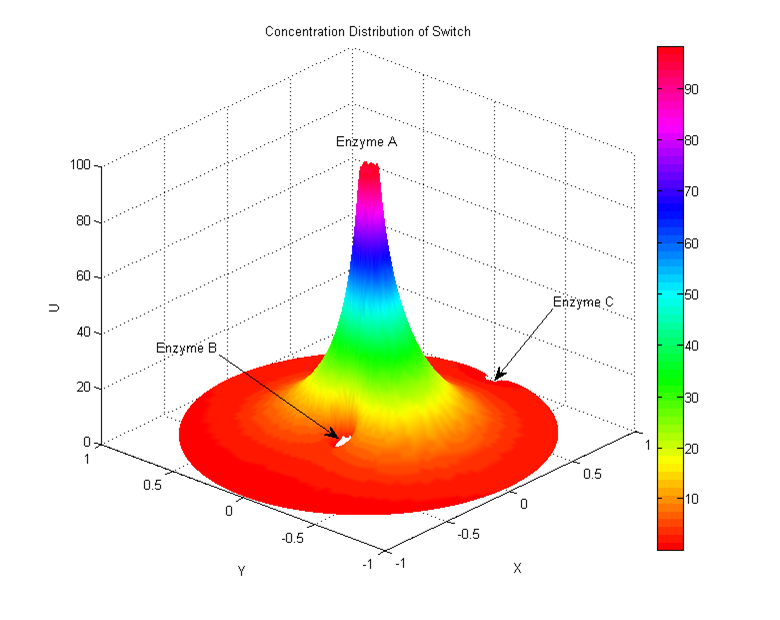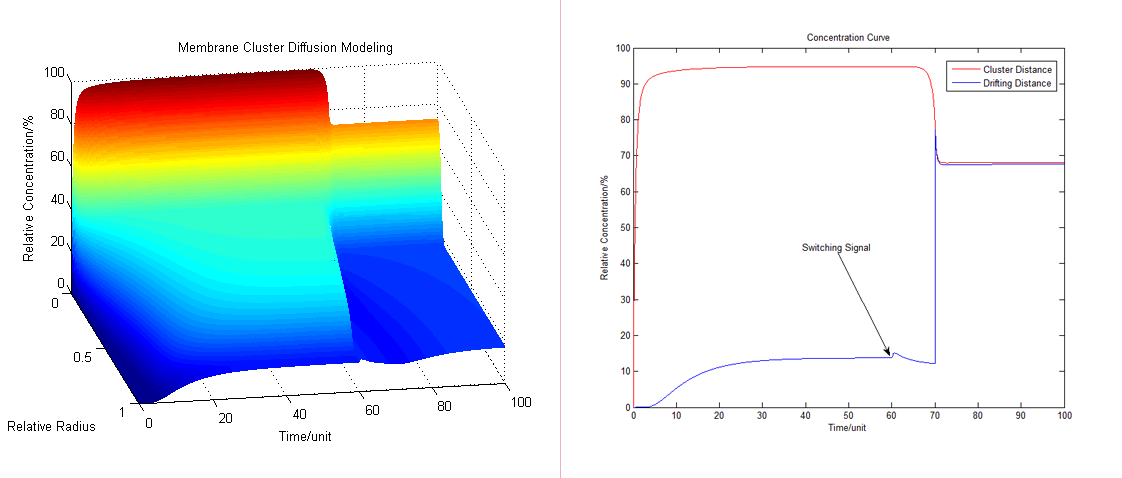Switch Modeling
In the membrane switching system either inner or outer signals can result in a rearrangement of our protein clusters. These interactions activated by signals can change the distances between enzymes, adjust the reaction rate and then finally alter the production amount. We assume that the random diffusion distance on the membrane is about 50-100 times the distance of our cluster interaction radius, and according to PDE model the concentration deceases with radius.
Under these basic assumptions we want to simulate the reaction progress and explain the mechanisms of redirection.
Working with a chain reaction which has different path ways, after getting a signal, the system will soon recruits dissociate membrane protein parts and alters the dynamic equilibrium of products. In other words, alters the amount and ratio of our final products.
Membrane Switch Model
Enzyme A consumes the primary substrate which has a constant concentration. The products of A (call it α) diffuse in an area of hemisphere. In our switch model, enzyme B and enzyme C all use α as the substrate to produce their products.
Enzymes in the enzyme cluster AB are adjacent to each other, and have a tendency to produce more products that enzyme C. Basic simulation shows that the concentration of substrate α distributes like this:
 Fig.7 Distribution of substrate α concentration To illustrate the diffusion behavior and the reaction progress, we assume that enzyme A locates on the center and produce α as the rate of (v_max [A])/(K_m+[A]), and enzyme B and enzyme C occupies the region of Ф1 and Ф2. In the beginning, enzyme B and C share different substrate concentration due to their distance to enzyme A. And enzyme B may produces much more products. Then we give the system a switch signal which can shorten the distance between enzyme A and C. The products of enzyme C rise because it gets more substrate than before. The percentage of these two products
The whole process in membrane switch can be simulated as following:
 Fig.8 Dynamic modeling of substrate α concentration before and after signaling At the beginning of all, the enzyme B and C locates on the membrane, A & B are linked together to make a cluster. With the time goes by the concentration of α quickly reaches a peak, and diffuses towards the outside. After producing for some time, the ratio of different products reaches a stable state. At time=60, the system receives a signal. Then enzyme approaches the cluster at a very fast speed and consumes more substrates. (Fig. 8)
 Fig.9 Integral and Ratio of product amount We call the product of Enzyme B as the major product. To show the equilibrium state after a long period of inducement, we assume that the signal comes at time=100. We can easily see that the major products product amount changes from about 70% of all products to 50%. In other words, the minor product amount has increased by 67%. (Fig. 9)
Discussion
In our model we assume that the reaction & substrate consumption abilities of B and C are the same. However in reality, the Km of different enzymes are not the same. Considering Michaelis-Menten equation, if the substrate concentration is 10 or more times the Km, we can ignore the effects of different abilities of enzymes, just as the normal biochemical conditions.
Amazingly our experiment results agree with the modeling ratio, these results strongly indicates the mechanism of steering process.
|